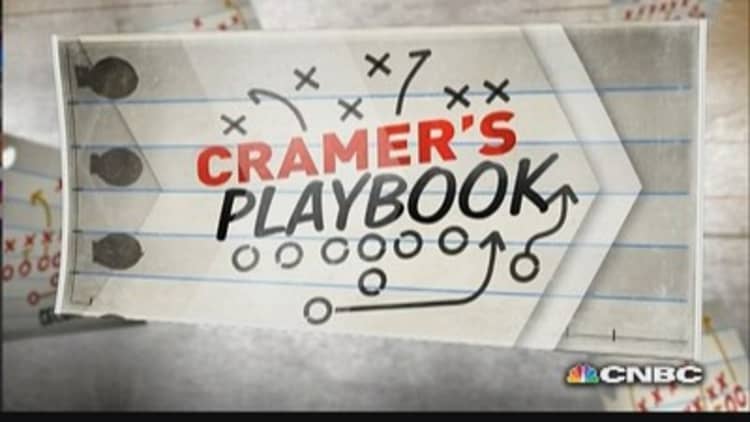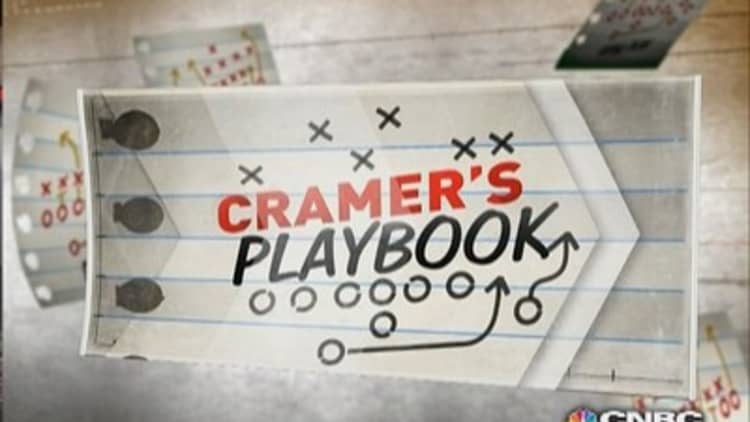
Feel like the pros know something that you don't? Cramer understands.
After reading and replying to countless Tweets from "Mad Money" fans, Cramer came to realize that widely practiced strategies, almost taken for granted by pros, are rarely passed along to individual investors.
Therefore, beginning in early 2014, "Mad Money" introduced a new franchise called "Cramer's Playbook" in which Cramer presented strategic concepts that he believes can augment wealth over the long-term.
"I'm on a constant mission not just to help you become a better investor but to help you generate the best return from every hard-earned penny," Cramer explained.
Although Cramer has presented a wide range of concepts as part of this special series, following are three tactical ideas that are specific to maximizing gains from buying and selling stocks.
Calculate PEG ratio before buying (from April 11, 2014)
Once you've done the necessary research or homework and you've identified a company whose stock you'd like to buy, you'll likely be faced with a challenging decision; are shares buyable at current levels?
Cramer believes one of the best ways to address the question is to determine the so-called PEG ratio, which is the P/E ratio divided by growth. Here's how it works.
"You just divide the P/E ratio (sometimes called the multiple) by the long-term growth rate," Cramer said. That's the PEG ratio. That's all there is too it.
And once you determine the PEG ratio, Cramer says you have a metric that allows you to make a decision on somewhat absolute terms.
"My rule of thumb, a guideline that I've arrived at based on more than three decades of trading and investing, is that I don't like to pay more than two times a company's growth rate for a given stock, meaning any stock with a PEG ratio of more than 2 is too pricey for me."
"So if a company has a 10% growth rate, but it's trading at a P/E of 20 or more (that's 20 times earnings), I'm generally inclined to say that's too expensive."
Conversely, I consider any stock that's trading at less than one times its growth rate, meaning it has a PEG ratio of less than one, to be cheap.

Sell decisions should not be influenced by capital gains tax (from April 3, 2014)
"A short-term capital gain gets taxed at the ordinary income tax rate, which can be as high as 39.6%," explained Jim Cramer. By contrast, "the long-term capital gains rate is just 15% for most people, although if you're in one of the higher tax brackets, that rate becomes 20% and even 23.8% in certain circumstances.
Clearly, you could save a bundle if you simply hold the stock for more than a year, but largely Cramer says it's a mistake to make decisions based on capital gains tax.
"Largely, you should never keep holding a stock just so you can avoid paying the higher short-term capital gains rate," the "Mad Money" host said.
-------------------------------------------------------------
Read more from Mad Money with Jim Cramer
If the smart money sells, should you sell too?
Buyers beware, cheap stocks aren't always bargains!
Mutual funds are hiding something from you
-------------------------------------------------------------
"Just think about it like this, okay? Imagine you owned all of those biotechs and cloud based software as service stocks that were red hot in 2013," he said. "Say you owned them for the last nine months of last year, right? And let's say you decided, 'these gains are so huge, I don't want to have to pay the tax man that horrible short-term capital gains rate. Instead, if I just hold them for three months longer so that the holding period is over year, I'll be in the clear and my tax bill on these holdings will be nearly cut in half thanks to the wonders of the long-term capital gains rate.'"
Had you followed that strategy, your gains would have evaporated at a breakneck pace. And, depending on the specific stocks, you may have lost your gains all together and ended in the red!

Stop loss orders can harm individual investors (from April 15, 2014)
"Stop-loss orders let you automatically sell a stock once it drops below a certain level," Cramer explained. Although they're very valuable for pros who move in and out of positions with aplomb, Cramer doesn't like them for individual investors, at all.
That's because stop-loss orders can trigger a sale when selling is a mistake. For example, if the fundamental thesis remains intact, the last thing Cramer advocates is selling into a decline.
Perhaps the textbook example stems from the Flash Crash of 2010, when the stock of declined from $60 to $40 and then back again in a matter of 30 minutes or so. An individual investor with a stop loss of $45 would have gotten stopped out, perhaps at a loss, when circumstances warranted anything other than selling.
That's not to say Cramer doesn't advocate actively managing your portfolio. During a selloff, Cramer recommends stepping back and identifying the catalysts behind the decline. If those catalysts change the thesis for owning your stock, then he suggests scaling out.
However, he doesn't want you to get taken out of a stock by a stop-loss order, simply because of a decline. That ignores the underlying thesis for owning a stock. "It's not how I want you to invest," Cramer said.

Call Cramer: 1-800-743-CNBC
Questions for Cramer? madmoney@cnbc.com
Questions, comments, suggestions for the "Mad Money" website? madcap@cnbc.com



